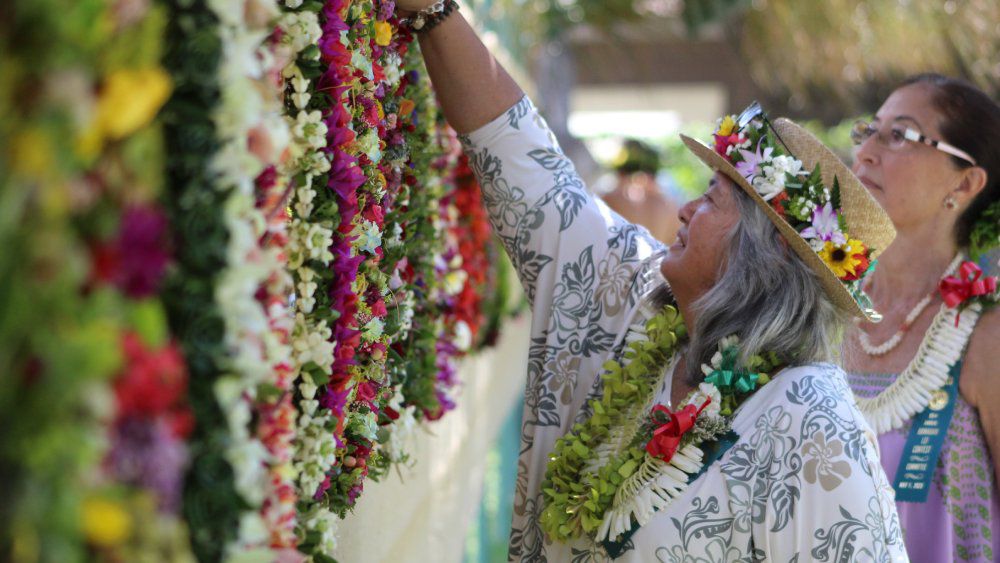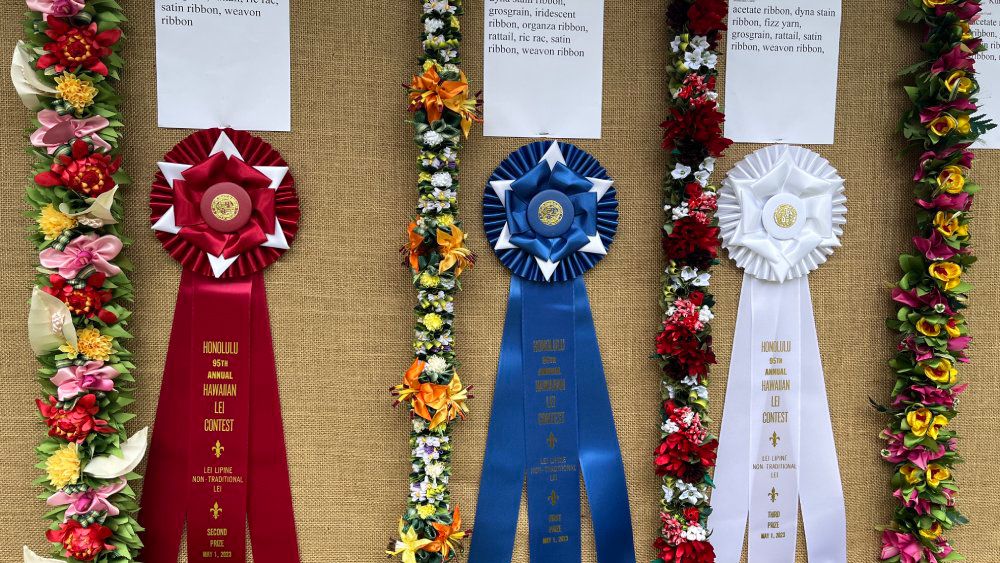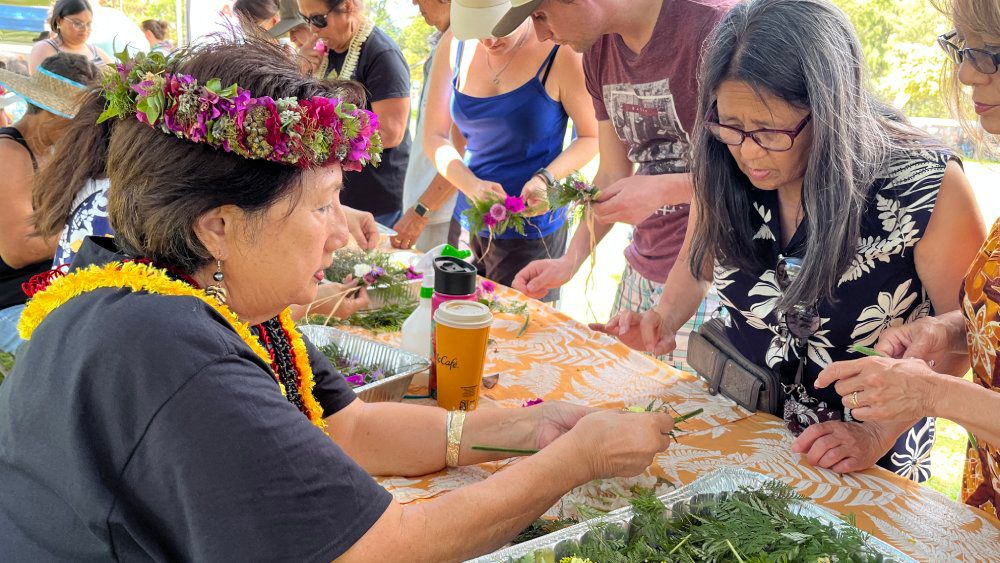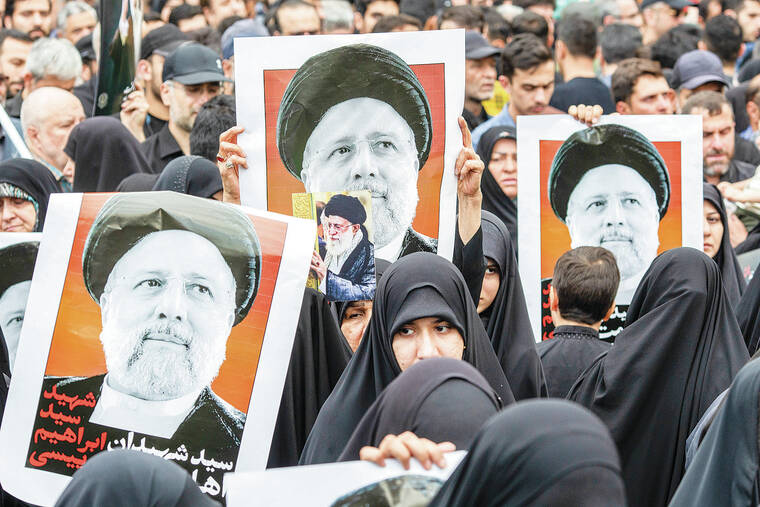Hawaii
Lei Day tradition continues on May 1

HONOLULU — The annual tradition of love for native Hawaiian culture and the symbolic lei continues with the 96th Lei Day Celebration taking place from 9 a.m. to 5 p.m. May 1 at the Kapiolani Park Bandstand.
In keeping with this year’s theme, the public is invited to “Komo mai kāu māpuna hoe” or “Dip your paddle in,” in other words, join in the effort. In this case, join in the fun and celebration as the skill and artistry of lei makers are showcased in the lei exhibit and local entertainment and hula halau take to the stage.
The Lei Day Court typically consists of one queen, first princess and princess. However, 2024 Lei Queen Tehina Kaʻena Kahikina will reign over this year’s festivities with her court of five princesses — Princesses Angela Jeanell Cezar Miranda, Makana Marie Wilson, Madison Kamalei Espinas, Sara No‘eau Campbell and Lulani Kaehulaniokekai Chung-Kuehu.
This isn’t the first time there have been more than two princesses.
“I can remember, just in my time, 2007, we had seven,” said Gina Loveland, a former employee with the Honolulu Department of Parks and Recreation from 2005 until after the COVID-19 pandemic.
“They protested. That was the time of (Daveanne) Manu Anana; before they even competed, they clicked. So they informed us,” said Loveland with a smile. Wanting to stay together as a group, the women said they were willing to contribute in paying for any additional costs the larger group would incur. “Anana was almost like the perfect queen. She was inclusive,” said Loveland.
(Photo courtesy of Honolulu Department of Parks and Recreation)
Loveland said she was impressed by Anana who performed her dance at the Kapiolani Park bandstand on Lei Day, easily maneuvering up and down the bandstand’s many steps like “Dorothy Lamour on the stage.”
Although she has since retired from the department, Loveland — together with her husband, Dennis, also a former DPR employee — continues to attend the annual event and help where she can.
Over many years, Lei Day drew her in like a fisherman pulling in his net because of the culture, authenticity and mainly the people — staff, lei makers, residents and visitors.
Loveland joined lei-making classes, learning the different sewing methods, and also met master lei makers such as Brian Choy, his brother Reynold, and Bill Char. “They’re so humble. And they did actually grow plants for lei.” Loveland said there was an atmosphere of sharing and widening the circle. She said they used to go hiking to find different ferns for the lei, something she wishes she had experienced.
She also learned much about the native florals. “One year the featured flower (of Lei Day) was ʻaʻaliʻi. And I’m thinking, ‘What the heck does it look like.’” Today she knows it’s a “brush and it’s supposed to like the wind and is known for being strong because it’s being buffeted.”

(Photo courtesy of Honolulu Department of Parks and Recreation)
Those wanting to enter a fresh flower lei in the contest can do so between 7:30 and 9 a.m. at the Lei Receiving Booth on event day. Following the judging and official opening of the exhibit by the Lei Court, the public will get to view the exhibit from 1 to 4:45 p.m.
The public can also enjoy performances by the Hawaiian Steel Guitar Association, 10 a.m. to 3 p.m. in the Lei Exhibit area, and artisans sharing their skills in the Kūlana Lei village. Vendors and event sponsors will also sell crafts, lei and food.
To Loveland, Lei Day is more than just an event. “Once I learned about the culture and met the people … it just really resonated.”
In addition to Lei Day, the public is also invited to attend the closing ceremony for the Lei Day Celebration that will be held the next day, May 2, at Mauna ʻAla (The Royal Mausoleum) at 9 a.m., and at Kawaiāhaʻo Church at about 10:15 a.m. Tradition calls for placing lei from the lei contest onto the graves of Hawaii’s aliʻi, royalty, at these two locations.
As much as Loveland enjoys the Lei Day Celebration, she deeply appreciates going to Mauna ʻAla and Kawaiāhaʻo Church. “I feel the respect, the origin (of Native Hawaiian culture). I also think most people think of lei as a tourist kind of thing.”
Loveland shares a story of one of her neighbors, a kūpuna named Austin, who was raised “Hawaiian style.” Whenever his mother or father went out to holoholo, Austin and his siblings would have to make lei for them. “Thatʻs why a lot of times when Austin — when he could walk — would come back with flowers all around his hat. He would pick flowers on the way. That was the culture,” said Loveland.

(Photo courtesy of Honolulu Department of Parks and Recreation)
“There’s an aura when you enter the grounds of Mauna ʻAla,” reflects Loveland. “There’s definitely an air of … I’m going to say peacefulness. I don’t want to say ‘somber’ because I don’t feel it’s sad. You can hear the pali, the traffic … but yeah, peaceful.”
Loveland says the crypt has been opened for the public to enter. “Dennis and I have gone down the steps with umbrellas helping the kūpuna.”
She explains that lauhala mats are put down first, then the natural lei — the lei made with yarn or other craft items are returned to their makers — from the lei contest exhibit are lined up on top of the mats. “The queen gets to choose first, then princesses, then staff, to give as hoʻokupu to the aliʻi.”
Loveland adds, “You go through an entryway and you can see the names engraved in the wall. There’s definitely awe … reverence. And definitely, history.”
Lei Day schedule:
- 9-9:45 a.m. – Performance by the Royal Hawaiian Band
- 10-10:45 a.m. – Kilohana Hula Show by the Council for Native Hawaiian Advancement presented by Southwest Airlines
- 11 a.m.-12:30 p.m. – Lei Court Ceremony
- 1-1:35 p.m. – Ei Nei performance
- 1:50-2:25 p.m. – Hōkū Zuttermeister performance
- 2:50-3:25 p.m. – Hoʻokena performance
- 3:40-4:10 p.m. – Mana Maoli Youth Collective performance
- 4:10-4:45 p.m. – Hālau Hula ʻO Hokulani performance
Sarah Yamanaka covers events, environmental and community news for Spectrum News Hawaii. She can be reached at sarah.yamanaka@charter.com.

Hawaii
Iran moves to project stability after crash kills key leaders

Iran sought to project a sense of order and control Monday by quickly naming an acting president and foreign minister a day after a helicopter crash killed both leaders. The change in leadership came at a time of heightened tensions in the Middle East and domestic discontent in Iran, where many residents have called for an end to decades of repressive clerical rule.
Iran’s supreme leader, Ayatollah Ali Khamenei, announced five days of mourning for the president, Ebrahim Raisi, 63, and the foreign minister, Hossein Amirabdollahian, 60, who died when their helicopter plunged into a mountainous area near the Iranian city of Jolfa. The men had been returning from Iran’s border with Azerbaijan after inaugurating a joint dam project.
Iran’s armed forces said they had created a committee to investigate the crash, which state media attributed to a “technical failure.”
Raisi, a hard-line cleric who came of age during the country’s Islamic Revolution, oversaw a deadly crackdown on protesters as the head of the judiciary in 2019 and as president in 2022. He had been widely viewed as a possible successor to Khamenei, 85.
On Monday, Khamenei named Iran’s first vice president, Mohammad Mokhber, acting president and announced that Mokhber would organize elections for a new president within 50 days. A conservative political operative, Mokhber has a long history of involvement in large business conglomerates closely tied to Khamenei.
Iran’s Cabinet appointed Ali Bagheri Kani, a deputy foreign minister, as the ministry’s “caretaker,” the IRNA state news agency reported. Bagheri Kani has served as Iran’s chief nuclear negotiator and was involved in a deal last year that freed imprisoned Americans in exchange for several jailed Iranians and eventual access to about $6 billion in Iranian funds.
Iranian officials said there would be a public procession in Tabriz, the closest big city to the site of the crash, on Tuesday and that the bodies would then be brought to Tehran for a state funeral.
“Raisi was tireless,” Khamenei said in a statement. “In this very sad incident, the people of Iran have lost a valuable and loyal public servant.”
Analysts in Iran said that while there was speculation about who might be elected as the next president, there was little question about the overall stability of the country or the government. They pointed out that Khamenei will remain supreme leader with power over major state policies.
Despite the official calls for mourning, many Iranians welcomed Raisi’s death, seeing him as one of the key figures in a corrupt regime who oversaw the execution of dissidents, used brutal violence to suppress and kill.
Hawaii
Report: Home Affordability In Hawaii Is 'As Bad As It’s Ever Been'

Only 1 in 5 households in Hawaii can afford to buy a single-family home — a dramatic drop from just three years ago, according to a grim housing report released by the University of Hawaii on Monday.
In 2021, 44% of Hawaii households could afford the mortgage on a median-priced single-family home. That figure is now 20%. As a result, home sales plummeted last year, hitting a 25-year low. But the slump had little impact on prices.
“We haven’t really seen any drop in prices, but there’s this huge increase in what it costs to buy a house because of interest rates,” said Justin Tyndall, an assistant professor of economics with the University of Hawaii Economic Research Organization and the lead author of the report. “Affordability is as bad as it’s ever been.”

High interest rates have had a crippling effect on would-be homeowners in the state by not only making mortgages significantly more unaffordable, but also reducing the number of houses on the market.
A majority of mortgage-holders in the state are paying an interest rate of less than 4%, according to the report, making many homeowners wary of putting their home on the market and trying to purchase something else at a much higher interest rate.
The state’s housing market has also worsened for renters in the last year. Hawaii has the highest median rents in the nation and a majority of renters — 56% — are considered “rent-burdened,” meaning they spend more than 30% of their income on rent.
The Maui fires worsened the state’s housing crisis, causing prices to rise while “the availability of rentals have plummeted,” according to the report.
Vacation Rentals And Out-Of-State Buyers
Short-term vacation rentals make up about 6% of the state’s housing stock, a figure that has grown in recent years but also varies dramatically by island. The number of active short-term rental listings grew 9% statewide between 2022 and 2023. Kauai saw the biggest spike, with a 22% jump in listings.
The number of short-term vacation rentals on Maui has actually increased slightly since the fires, despite the loss of 380 vacation rentals in West Maui and tax incentives for unit owners across the island to convert their units into long-term housing.
“The policy was supposed to incentivize a bigger shift away from vacation rentals and toward housing locals, but we haven’t really seen that in the aggregate,” Tyndall said.
While short-term vacation listings on Maui plummeted after the fire, they are now 2% higher than they were a year ago.


The report also found that “a significant portion of Hawaii’s property owners” are not residents of the state. People from out of state made up 13% of property owners on Oahu and 32% on Maui. More than half of property owners in Lahaina had an out-of-state mailing address.
On Maui, about 85% of vacation rentals are owned by people from out of state, Tyndall said.
Another big takeaway from the overall data, Tyndall said, is that the state isn’t building enough housing to have any real impact on affordability. The state has significant issues with permitting delays, although some progress has been made in the last year in multiple counties, according to the report.
However, strict limits on where multi-family homes can be constructed, along with steep developer fees and permitting delays contribute to the high costs of condos and “reduce the amount of new housing the state.”
“While many households have a preference for single-family homes, building high-rise condominiums can provide many more units, allowing vacancies to propagate across the market, and pushing down housing prices everywhere, including for single-family homes,” the report says.
Converting thousands of vacation rentals into long-term rentals — which Maui’s mayor is proposing to do — could have a really significant impact on affordability, Tyndall said.

Sign up for our FREE morning newsletter and face each day more informed.
Hawaii
Hawaii DOT, police departments launch annual ‘Click it or Ticket’ campaign

HONOLULU (HawaiiNewsNow) – The state Department of Transportation launched its annual “Click it or Ticket” campaign Monday in an effort to remind driver of the importance of wearing a seatbelt.
Police departments across the state are bolstering enforcement efforts as well.
“The great thing is Hawaii leads the nation in usage — with nearly 98% — but we dropped off from last year,” said Hawaii Department of Transportation Director Ed Sniffen.
“It’s a big thing. We also see right now that of in the last four years, of the people who died in their vehicles in Hawaii, half of them weren’t using their seatbelts.”
The cost of a ticket for not buckling up is $102 on Oahu, Maui and Hawaii, and $112 on Kauai.
For more information on Hawaii’s ‘Click it or Ticket’ campaign, click here.
Copyright 2024 Hawaii News Now. All rights reserved.
-

 News1 week ago
News1 week agoSkeletal remains found almost 40 years ago identified as woman who disappeared in 1968
-

 Movie Reviews1 week ago
Movie Reviews1 week ago“Kingdom of the Planet of the Apes”: Disney's New Kingdom is Far From Magical (Movie Review)
-

 World1 week ago
World1 week agoIndia Lok Sabha election 2024 Phase 4: Who votes and what’s at stake?
-

 World1 week ago
World1 week agoUkraine’s military chief admits ‘difficult situation’ in Kharkiv region
-

 World1 week ago
World1 week agoCatalans vote in crucial regional election for the separatist movement
-

 Movie Reviews1 week ago
Movie Reviews1 week agoAavesham Movie Review
-

 Politics1 week ago
Politics1 week agoNorth Dakota gov, former presidential candidate Doug Burgum front and center at Trump New Jersey rally
-

 News1 week ago
News1 week agoTrump, Reciting Songs And Praising Cannibals, Draws Yawns And Raises Eyebrows




















